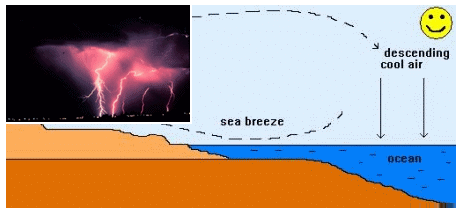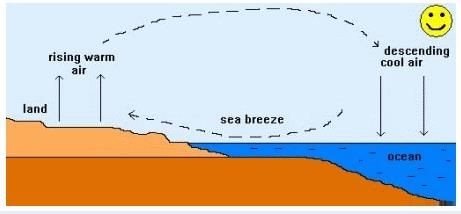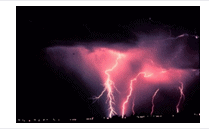Class 7 Science Question Answers - Winds, Storms and Cyclones
Short Q & A :
Q1: Why are people advised not to stand near fast moving train?
Ans : When train moves with high speed it creates region of lower pressure. This low pressure pushes man towards the train.
Q2: Explain wind.
Ans : Wind is air in motion. It is produced by the uneven heating of the earth’s surface by the sun. Since the earth’s surface is made of various land and water formations, it absorbs the sun’s radiation unevenly. Two factors are necessary to specify wind: speed and direction.
Q3: What causes the wind to blow?
Ans : As the sun warms the Earth's surface, the atmosphere warms too. Some parts of the Earth receive direct rays from the sun all year and are always warm. Other places receive indirect rays, so the climate is colder. Warm air, which weighs less than cold air, rises. Then cool air moves in and replaces the rising warm air. This movement of air is what makes the wind blow.
Q4: What is a windstorm?
Ans : A windstorm is just a storm with high winds or violent but with little or no rain.
Q5: Explain monsoon.
Ans : A monsoon is a seasonal wind, found especially in Asia that reverses direction between summer and winter and often brings heavy rains. In the summer, a high pressure area lies over the Indian Ocean while a low exists over the Asian continent. The air masses move from the high pressure over the ocean to the low over the continent, bringing moisture-laden air to south Asia. During winter, the process is reversed and a low sits over the Indian Ocean while a high lies over the Tibetan plateau so air flows down the Himalaya and south to the ocean.
Q6: What are the global wind patterns?
Ans :
The equator receives the Sun's direct rays. Here, air is heated and rises, leaving low pressure areas behind. Moving to about thirty degrees north and south of the equator, the warm air from the equator begins to cool and sink. Between thirty degrees latitude and the equator, most of the cooling sinking air moves back to the equator. The rest of the air flows toward the poles.

Q7: Explain sea breeze.
Ans : In a warm summer day along the coast, this differential heating of land and sea leads to the development of local winds called sea breezes. As air above the land surface is heated by radiation from the Sun, it expands and begins to rise, being lighter than the surrounding air. To replace the rising air, cooler air is drawn in from above the surface of the sea. This is the sea breeze, and can offer a pleasant cooling influence on hot summer afternoons.
Q8: Explain sea breeze with a diagram.
Ans :

Q9: Explain land breeze.
Ans : A land breeze occurs at night when the land cools faster than the sea. In this case, it is air above the warmer surface water that is heated and rises, pulling in air from the cooler land surface.
Q10: Explain land breeze with a diagram.
Ans : 
Q11: How is wind helpful to Earth?
Ans : Wind is the fastest growing source of electricity in the world. It's often one of the least expensive forms of renewable power available. Some experts say it can sometimes be the cheapest form of any kind of power. Generating power from the wind leaves no dangerous waste products behind. Best of all, its supply is unlimited.
Q12: How do windmills work?
Ans : Windmills work because they slow down the speed of the wind. The wind flows over the air foil shaped blades causing lift, like the effect on airplane wings, causing them to turn. The blades are connected to a drive shaft that turns an electric generator to produce electricity.
Q13: What causes a thunderstorm?
Ans : The basic ingredients used to make a thunderstorm are moisture, unstable air and lift. You need moisture to form clouds and rain. You need unstable air that is relatively warm and can rise rapidly. Finally, you need lift. This can form from fronts, sea breezes or mountains.
Q14: What is lightning?
Ans : Lightning is a bright flash of electricity produced by a thunderstorm. All thunderstorms produce lightning and are very dangerous. If you hear the sound of thunder, then you are in danger from lightning. Lightning kills and injures people and properties.

Q15: What causes lightening?
Ans : Lightning is an electric current. Within a thundercloud way up in the sky, many small bits of ice (frozen raindrops) bump into each other as they move around in the air. All of those collisions create an electric charge. After a while, the whole cloud fills up with electrical charges. The positive charges or protons form at the top of the cloud and the negative charges or electrons form at the bottom of the cloud. Since opposites attract, that causes a positive charge to build up on the ground beneath the cloud. The grounds electrical charge concentrates around anything that sticks up, such as mountains, people, or single trees. The charge coming up from these points eventually connects with a charge reaching down from the clouds and - zap - lightning strikes!
Q16: How you can find out wind direction at a given place.
Ans : We can find the wind direction using a Wind Vane or Weather Vane or Weather Cock. It consists of a flat metallic sheet generally cut into shape of a cock or arrow which is mounted on disk and free to move around a axial shaft and point in the direction of wind . They are typically used as an architectural ornament to the highest point of a building. Alsowe can find the direction of light wind using smoke from incense sticks. The direction of smoke will indicate the wind direction.
Q17: State an experiment to show that air exerts pressure.
Ans : Filling air in a football: A football filled tight with air, takes a shape of a sphere which is very difficult to press and can even support the weight of a player.
Q18: You want to buy a house. Would you like to buy a house having windows but no ventilators? Explain your answer.
Ans : We would not buy a house having windows but no ventilators, as there will be no cross ventilation of air inside the room. Fresh cool Air entering the room through window gets heated through human and other household activities like breathing, cooking and become lighter, this warm air rises up inside the room. If there is no ventilator near the roof, the warm air will have no passage to leave as the level of window is quite low from the level of warm air. This will increase the room temperature as well as humidity inside leading to human discomfort.
Q19: How will you help your neighbours in case cyclone approaches your village/town?
Ans : In case cyclone approaches our village or town, we can help our neighbours in following way :
- We should not ignore the warnings issued by the meteorological department through TV, radio, or newspapers.
- We should make necessary arrangements to shift the essential household goods, domestic animals and vehicles, etc. to safer places;
- Avoid driving on roads through standing water, as floods may have damaged the roads; and keep ready the phone numbers of all emergency services like police, fire brigade, and medical centres.
- Do not drink water, that could be contaminated. Always store drinking water for emergencies.
- Do not touch wet switches and fallen power lines.
- Do not go out just for the sake of fun.
- Do not pressurise the rescue force by making undue demands
- Cooperate and help your neighbours and friends
Q20: What planning is required in advance to deal with the situation created by a cyclone?
Ans : With help of satellites and radars, Cyclone alert or Cyclone watch is issued 48 hours in advance of any expected storm and a Cyclone warning is issued 24 hrs in advance. The message is broadcast every hour or half hour when a cyclone is nearer the coast. We should not ignore the warnings issued by the meteorological department through TV, radio, or newspapers.We should make necessary arrangements to shift the essential household goods, domestic animals and vehicles, etc. to safer places.
Q21: Explain why holes are made in hanging banners and hoardings
Ans : The banner and hoarding are generally having a large surface area and are put out side in open where they may subject to varying air pressure depending on wind conditions. If wind pressure is high, then air will exert a great amount of pressure on the banners or hoarding causing it to flutter or blown away. To prevent this, holes are made in hanging banner and hording, through which air pressure gets leaked causing less damage or fluttering to banners or hoarding.
Q22: Why are holes made in huge hoardings?
Ans : Holes are made in huge hoardings to reduce air pressure causing it to flutter or blown away.
Q23: In winter regions near, why does wind blow from land to sea?
Ans : In winter the sea become warmer quickly than the land. So In winter monsoon blows from land to sea.
Q24: What are the effects of cyclones?
Ans : The main effects of tropical cyclones include heavy rain, strong wind, large storm surges at landfall, and tornadoes. The destruction from a tropical cyclone depends mainly on its intensity, its size, and its location.
Q25: How do cyclones effect the environment?
Ans :
Severe tropical cyclones are responsible for large number of causalities and considerable damage to property and agricultural crop. The destruction is confined to the coastal districts and the maximum destruction being within 100 km from the centre of the cyclone and on the right side of the storm track.
Principal dangers from cyclones are:
- very strong winds
- torrential rain and
- high storm tides
Q26: What is an anemometer?
Ans : An anemometer is a device for measuring wind speed, and is a common weather station instrument.
Q27: What is a tornado?
Ans : A tornado is a violent rotating column of air extending from a thunderstorm to the ground. The most violent tornadoes are capable of tremendous destruction with wind speeds of up to 300 mph. They can destroy large buildings, uproot trees and hurl vehicles hundreds of yards. They can also drive straw into trees
Q28: How do tornadoes form?
Ans : Most tornadoes form from thunderstorms. You need warm, moist air from the Gulf of Mexico and cool, dry air from Canada. When these two air masses meet, they create instability in the atmosphere. A change in wind direction and an increase in wind speed with increasing height creates an invisible, horizontal spinning effect in the lower atmosphere. Rising air within the updraft tilts the rotating air from horizontal to vertical. An area of rotation, 2-6 miles wide, now extends through much of the storm. Most strong and violent tornadoes form within this area of strong rotation.
Q29: What do tornadoes look like?
Ans : Tornadoes can appear as a traditional funnel shape, or in a slender rope-like form. Some have a churning, smoky look to them, and other contains "multiple vortices", which are small, individual tornadoes rotating around a common center. Even others may be nearly invisible, with only swirling dust or debris at ground levels as the only indication of the tornado's presence.
Q30: What is a Mesocyclones?
Ans : A Mesocyclones is a rotating vortex of air within a supercell thunderstorm. Mesocyclones do not always produce tornadoes.
Long Q & A :
Q1: Explain wind storms and cyclones along with their effects?
Ans :
A windstorm is just a storm with high winds or violent but with little or no rain.
The main effects of tropical cyclones include heavy rain, strong wind, large storm surges at landfall, and tornadoes. The destruction from a tropical cyclone depends mainly on its intensity, its size, and its location.
Severe tropical cyclones are responsible for large number of causalities and considerable damage to property and agricultural crop. The destruction is confined to the coastal districts and the maximum destruction being within 100 km from the centre of the cyclone and on the right side of the storm track. Principal dangers from cyclones are: (i) very strong winds, (ii) torrential rain, and (iii) high storm tides.
In case cyclone approaches our village or town, we can help our neighbours in following way :
- We should not ignore the warnings issued by the meteorological department through TV, radio, or newspapers.
- We should make necessary arrangements to shift the essential household goods, domestic animals and vehicles, etc. to safer places;
- Avoid driving on roads through standing water, as floods may have damaged the roads; and keep ready the phone numbers of all emergency services like police, fire brigade, and medical centres.
- Do not drink water, that could be contaminated. Always store drinking water for emergencies.
- Do not touch wet switches and fallen power lines.
- Do not go out just for the sake of fun.
- Do not pressurise the rescue force by making undue demands
- Cooperate and help your neighbours and friends
With help of satellites and radars, Cyclone alert or Cyclone watch is issued 48 hours in advance of any expected storm and a Cyclone warning is issued 24 hrs in advance. The message is broadcast every hour or half hour when a cyclone is nearer the coast. We should not ignore the warnings issued by the meteorological department through TV, radio, or newspapers.We should make necessary arrangements to shift the essential household goods, domestic animals and vehicles, etc. to safer places.
Q2: Explain how we can find wind direction at a given place.
Ans : We can find the wind direction using a Wind Vane or Weather Vane or Weather Cock. It consists of a flat metallic sheet generally cut into shape of a cock or arrow which is mounted on disk and free to move around a axial shaft and point in the direction of wind . They are typically used as an architectural ornament to the highest point of a building. Alsowe can find the direction of light wind using smoke from incense sticks. The direction of smoke will indicate the wind direction.
FAQs on Class 7 Science Question Answers - Winds, Storms and Cyclones
| 1. What causes wind? |  |
| 2. How are storms formed? |  |
| 3. What are the characteristics of a cyclone? |  |
| 4. How do cyclones get their names? |  |
| 5. Can wind speed be measured? |  |

|
Explore Courses for Class 7 exam
|

|


















